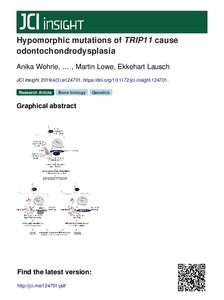Hypomorphic mutations of TRIP11 cause odontochondrodysplasia
Schoner K; Welting T; Follit JA; Schneider J; Spranger J; Hermann J; Schmidts M; Fano V; Zabel B; Hietala M; Nishimura G; Bloch-Zupan A; Lausch E; Unger S; Witkos TM; Lowe M; Wehrle A; Vatanavicharn N; Pazour GJ; Superti-Furga A
Hypomorphic mutations of TRIP11 cause odontochondrodysplasia
Schoner K
Welting T
Follit JA
Schneider J
Spranger J
Hermann J
Schmidts M
Fano V
Zabel B
Hietala M
Nishimura G
Bloch-Zupan A
Lausch E
Unger S
Witkos TM
Lowe M
Wehrle A
Vatanavicharn N
Pazour GJ
Superti-Furga A
AMER SOC CLINICAL INVESTIGATION INC
Julkaisun pysyvä osoite on:
https://urn.fi/URN:NBN:fi-fe2021042825291
https://urn.fi/URN:NBN:fi-fe2021042825291
Tiivistelmä
Odontochondrodysplasia (ODCD) is an unresolved genetic disorder of skeletal and dental development. Here, we show that ODCD is caused by hypomorphic TRIP11 mutations, and we identify ODCD as the nonlethal counterpart to achondrogenesis 1A (ACG1A), the known null phenotype in humans. TRIP11 encodes Golgi-associated microtubule-binding protein 210 (GMAP-210), an essential tether protein of the Golgi apparatus that physically interacts with intraflagellar transport 20 (IFT20), a component of the ciliary intraflagellar transport complex B. This association and extraskeletal disease manifestations in ODCD point to a cilium-dependent pathogenesis. However, our functional studies in patient-derived primary cells clearly support a Golgi-based disease mechanism. In spite of reduced abundance, residual GMAP variants maintain partial Golgi integrity, normal global protein secretion, and subcellular distribution of IFT20 in ODCD. These functions are lost when GMAP-210 is completely abrogated in ACG1A. However, a similar defect in chondrocyte maturation is observed in both disorders, which produces a cellular achondrogenesis phenotype of different severity, ensuing from aberrant glycan processing and impaired extracellular matrix proteoglycan secretion by the Golgi apparatus.
Kokoelmat
- Rinnakkaistallenteet [19207]
